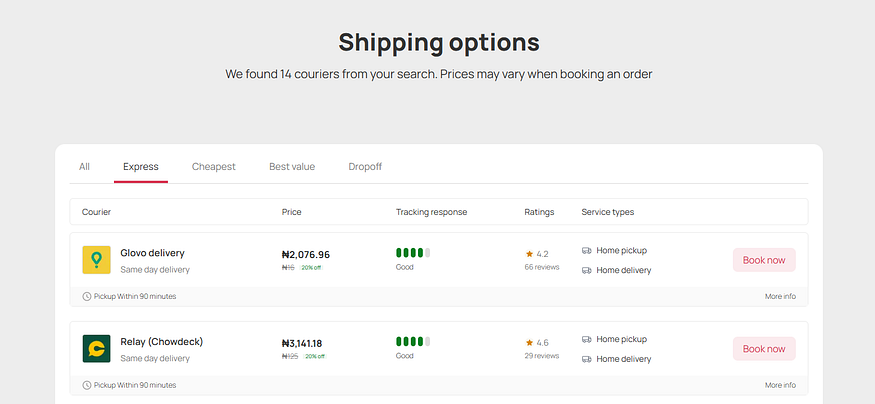How user-centered design can unify fragmented Multi-Carrier Shipping/Delivery Experiences in Africa and improve trust across Africa’s logistics and e-commerce ecosystem.
In Africa, no two carriers work the same. Each courier has its own processes, tracking methods, API constraints (or lack thereof), and regional quirks. For a logistics or e-commerce platform, integrating multiple carriers is not just a backend challenge — it’s a UX, UI, and system design challenge.
From my experience designing for Shipbubble and Sendbox, I’ve learned that simplifying multi-carrier workflows can make or break user adoption. When you get it right, your users (merchants, operators, dispatchers) feel empowered; when it’s wrong, processes break, users get frustrated, and support tickets skyrocket.
In this article, we will explore:
- Why multi-carrier shipping in Africa is uniquely hard
- Key UX challenges when designing for multiple couriers
- Strategies & patterns to simplify the experience
- Case study / hypothetical flows
- What to watch for: future trends & AI
Post Outline
Why Multi-Carrier Shipping in Africa is Uniquely Hard
Poor Infrastructure & Digital Ecosystem
Logistics in Africa struggle with infrastructure, broken systems, and limited digital maturity. As Logistics Challenges in Sub-Saharan Africa and Opportunities for Digitalization shows, many operators have to work around infrastructural gaps, limited tracking, and inconsistent data flows. mdpi.com
When you have multiple couriers, each might send you tracking updates differently, some via API, others via SMS, others via email, and sometimes none at all. That makes synchronizing data hard, and designing reliable user experiences even harder.
Regional Differences & Carrier Diversity
A carrier in Lagos might work very differently from one in Johannesburg or Accra. Different tech maturity, different operational expectations, different workflows. And many local couriers may only support phone/WhatsApp dispatch, with no proper API. This regional inconsistency forces designers to build flexible and fault-tolerant systems.
Operational Delays & Unpredictability
Delays from customs, road conditions, and port congestion are all quantified in academic and practitioner research. Medium+2mdpi.com+2 These uncertainties create unpredictable data, which complicates UX. Users expect real-time status, but backend updates may be delayed, missing, or erroneous.
Key UX Challenges When Designing for Multi-Carrier Systems
Unified Tracking Interface
Users want to see “Where is my package?” across all carriers. But carriers’ updates arrive in different formats and times. Product Designers must design a streamlined tracking interface that accommodates all types of statuses (“Picked Up, In Transit, Out for Delivery, Delivered, etc.), hides carrier inconsistencies, and shows meaningful progress.
Carrier Selection & Onboarding
When a merchant adds a shipment, they may choose among multiple couriers. It needs to be simple: compare cost, estimated delivery time, reliability, coverage. UX must present this clearly. If selection is confusing, merchants will default to one courier.
Error Handling & Fallbacks
What if one courier’s API fails? Or tracking data stops arriving? The UI must gracefully show the last known status, alert the user, and allow fallback options (e.g., “Try alternate carrier” or “Contact courier directly”).
Consistent UX Across Carriers
Different carriers may present different workflows: some let you request pickup, others require scheduling, and others only offer drop-off. Your UI must streamline the user journey so users don’t feel they’re switching between different apps.
Mobile Constraints & Connectivity
Many African users operate on mobile devices, with possibly poor connectivity. Multi-carrier flows must be lightweight, offline-aware, and gracefully handle network issues.
Notifications & Updates
Users expect push/SMS/WhatsApp updates. But carriers may only send SMS or manual updates. UX must translate those into unified notifications. For example, if the courier sends an SMS update, your app should read it (if allowed) or let operations staff manually enter statuses to keep the user informed.
Read Also: Designing for African Logistics Platforms: Building User-centered Systems for a Complex Market
Strategies & Patterns to Simplify the Experience
Use Progressive Disclosure
Especially for multi-carrier settings, hide complexity until needed. For first-time users, show only basic choices (“Fastest vs Cheapest”). Advanced users can drill into carrier-specific settings.
Visual Progress Bars
Use visual status bars that map carrier statuses into unified stages (e.g., Pickup → In Transit → Out for Delivery → Delivered). The user doesn’t need to know the carrier’s internal processes, just what each stage means.
Retry & Error Modals
Design modals that trigger when a carrier fails to send updates: “Carrier’s tracking is delayed, would you like to retry again?” Let users take control rather than being stuck.
Carrier Comparison UI
When a merchant selects a carrier, show comparison cards: price, estimated time, reliability (if known), and user feedback, etc. Good UX helps users choose intelligently.
Offline-First Design
Cache the last known statuses. If the network fails, allow the user to continue the workflow, then sync when the connection is restored.
Case Study / Hypothetical Flow: Merchant Ships via Two Carriers
Here’s a simplified flow, based on real problems I encountered and resolved at Shipbubble:

Merchant creates a shipping order → system fetches rates from Courier A & Courier B → shows two cards: Courier A: Price, Timeline, Tracking Response, Rating, etc. Courier B: Price, Timeline, Tracking Response, Rating, etc.
Merchant books Courier A → UI shows processing and then proceeds to the “Shipping summary and payment” screen. If Courier A API fails, UI shows fallback message: “Courier failed, try Courier B?”
Once booking succeeds, the UI adds a tracking component: shows a progress bar (Pickup → Transit → Out for Delivery).

The courier sends an SMS with status update to the merchant.
Mobile user sees push / in-app notification: “Your shipment is out for delivery via Courier A.”
If Courier A’s tracking fails for 24 hours, UI shows message → “We don’t have new updates. Would you like to contact support?”
This flow dramatically reduced merchant frustration, increased successful bookings, and cut support tickets in testing phases.
Future Trends: AI & Multi-Carrier Logistics UX
AI-powered Carrier Recommendation
Given past performance, AI can suggest which courier is likely to be fastest, most reliable, or cheapest for a given route.
Chatbots / Assistant Interfaces
Integrate chat assistants that translate user questions (“Where is my package?”) into queries across multiple carriers, aggregate responses, and respond in natural language.
Predictive Status Forecasts
Use AI to predict where a package should be given past data + route + delays. Show “Estimated next status in 12 hours” even before courier updates arrive.
Why This Matters for Product Designers & E-commerce Professionals
If you’re designing logistics or e-commerce platforms targeting African markets, mastering multi-carrier UX isn’t optional; it’s essential. It bridges operational complexity, gives users clarity, and builds trust. Good UX here can be the difference between adoption and abandonment.
My previous article, “Designing for African Logistics Platforms: Building User-Centered Systems for a Complex Market,” explored broader challenges. This article is a deep dive into the multi-carrier layer, where much of the real friction lives.
